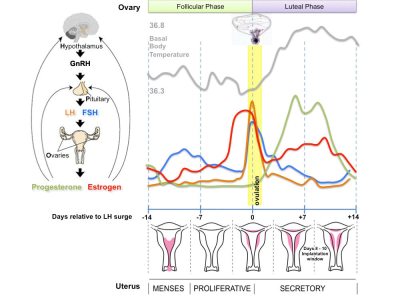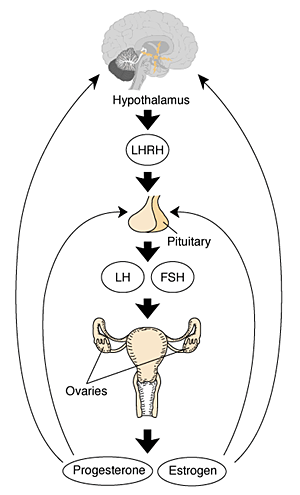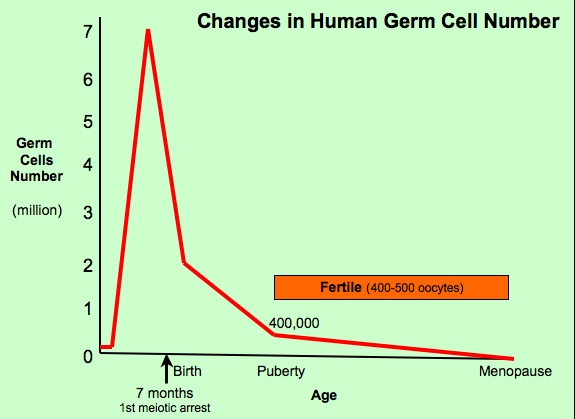Menstrual Cycle: Difference between revisions
| Line 59: | Line 59: | ||
| Normal limits (5th - 95th percentiles) | | Normal limits (5th - 95th percentiles) | ||
|-bgcolor=" | |-bgcolor="pale blue" | ||
| Frequency of menses (days) | | Frequency of menses (days) | ||
| Frequent | | Frequent | ||
Revision as of 00:23, 21 April 2010
Introduction
The human reproductive cycle, an cyclic endocrine regulated change in female anatomy and physiology that occur over 28 days (4 weeks, a lunar month) during reproductive life (between puberty and menopause). Endocrine changes during pregnancy block the menstrual cycle, which normally would shed the functional layer of the uterine lining each cycle.
This cycle differs from other non-primate female vertebrates (eg rats, mice, horses, pig) that have a reproductive cycle called the estrous cycle (oestrous, British spelling).
- The average menstrual cycle is 28 days with ovulation (egg release) occuring approximately the middle of the cycle.
- The last menstrual period is used clinically in determining developmental ages. (More Birth Date)
- Menstruation phase (period) is the loss of the uterus epithelial functional layer and occurs if fertilization and implantation has not occurred before the end of the current cycle.
Ovulation (HPG Axis)
- Hypothalmus releases gonadotropin releasing hormone (GRH, luteinizing hormone–releasing hormone, LHRH) -> Pituitary releases follicle stimulating hormone (FSH) and lutenizing hormone (LH) -> ovary follicle development and ovulation.
- release of the secondary oocyte and formation of corpus luteum
- secondary oocyte encased in zona pellucida and corona radiata
- Ovulation associated with follicle rupture and ampulla movement
Human Oocyte Numbers
- The graph shows the changes in human germ cell numbers in the ovary with age, peaking at about 7 million (occuring in early fetal development) and then decreasing by apopotic cell death.
- At puberty there remain only about 400,000 and only about 10% of these will be released through reproductive life.
- Graph based on data from: Hassold, etal., Environ Mol Mutagen 1996. 28: 167-175
Oocyte Development
Primary Oocyte
- arrested at early Meiosis 1
- diploid: 22 chromosome pairs + 1 pair X chromosomes (46, XX) autosomes and sex chromosome
- Oogenesis- pre-antral then antral follicle (Graafian follicle is mature antral follicle released)
Secondary Oocyte
- 1 Day before ovulation completes (stim by LH) Meiosis 1
- haploid: 22 chromosomes + 1 X chromosome (23, X)
- nondisjunction- abnormal chromosome segregation
- begins Meiosis 2 and arrests at metaphase
- note no interphase replication of DNA, only fertilization will complete Meiosis 2
Menstrual Parameters
Based upon normal mid-reproductive years, table from international agreement discussion.[1]
| Clinical dimensions of menstruation and menstrual cycle | Descriptive terms | Normal limits (5th - 95th percentiles) |
| Frequency of menses (days) | Frequent | <24 |
| Normal | 24 - 38 | |
| Infrequent | >38 | |
| Regularity of menses (cycle to cycle variation over 12 months; in days) | Absent | - |
| Regular | Variation ± 2 to 20 days | |
| Irregular | Variation greater than 20 days | |
| Duration of flow (days) | Prolonged | >8.0 |
| Normal | 4.5 - 8.0 | |
| Shortened | <4.5 | |
| Volume of monthly blood loss (ml)[2] | Heavy | >80 |
| Normal | 5 - 80 | |
| Light | <5 |
References
- ↑ Can we achieve international agreement on terminologies and definitions used to describe abnormalities of menstrual bleeding? Fraser IS, Critchley HO, Munro MG, Broder M. Hum Reprod. 2007 Mar;22(3):635-43. Epub 2007 Jan 4. PMID: 17204526 | Hum Reprod.
- ↑ Menstrual blood loss--a population study. Variation at different ages and attempts to define normality. Hallberg L, Högdahl AM, Nilsson L, Rybo G. Acta Obstet Gynecol Scand. 1966;45(3):320-51. PMID: 5922481
Search Pubmed: Menstrual Cycle | corpus luteum
Additional Images
Internet Links
Women’s Health Queensland Wide - Understanding Your Menstrual Cycle
Glossary Links
- Glossary: A | B | C | D | E | F | G | H | I | J | K | L | M | N | O | P | Q | R | S | T | U | V | W | X | Y | Z | Numbers | Symbols | Term Link
Cite this page: Hill, M.A. (2024, May 6) Embryology Menstrual Cycle. Retrieved from https://embryology.med.unsw.edu.au/embryology/index.php/Menstrual_Cycle
- © Dr Mark Hill 2024, UNSW Embryology ISBN: 978 0 7334 2609 4 - UNSW CRICOS Provider Code No. 00098G








